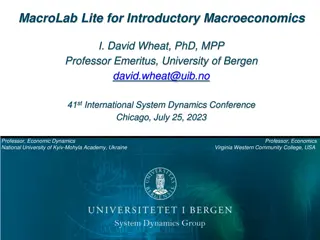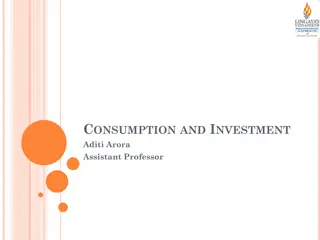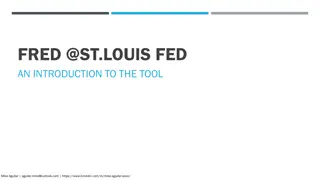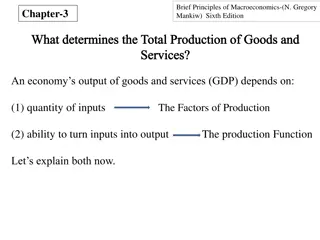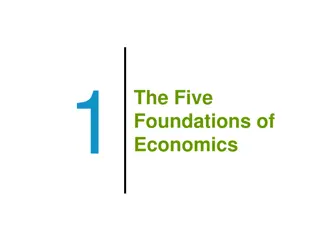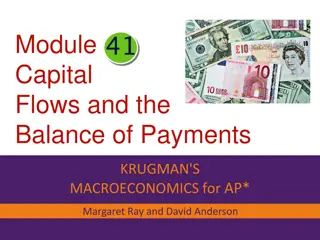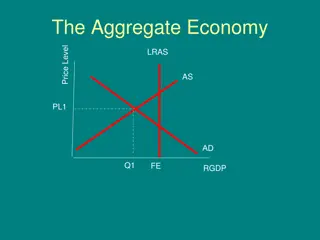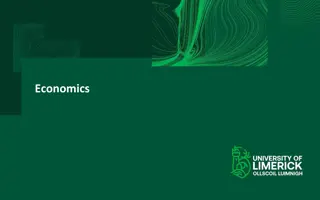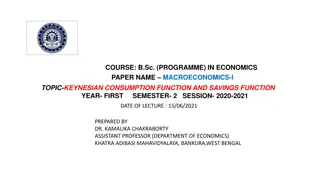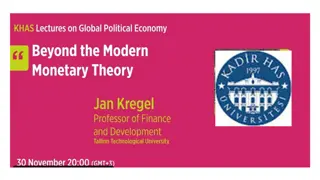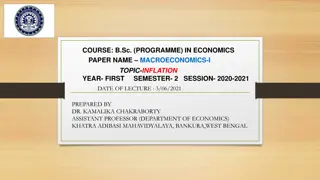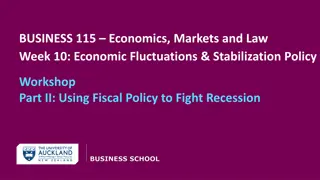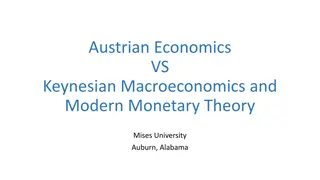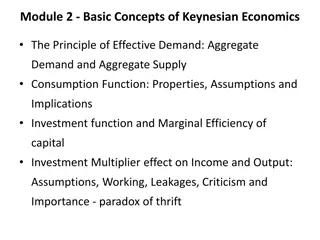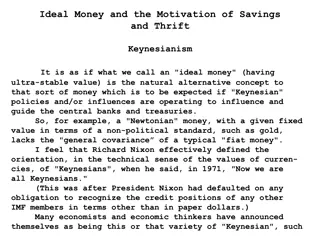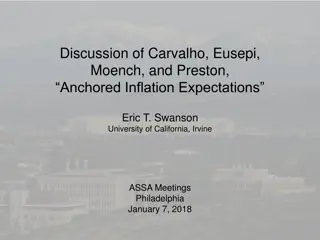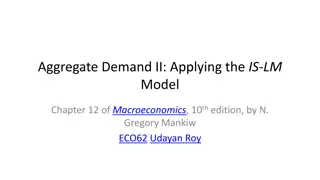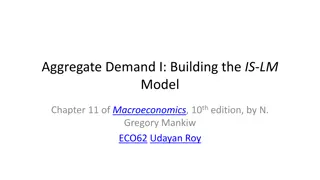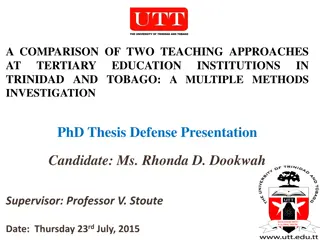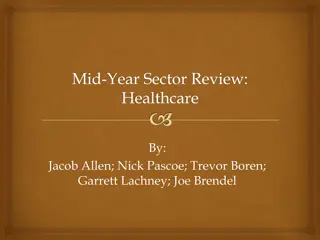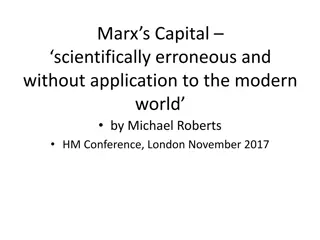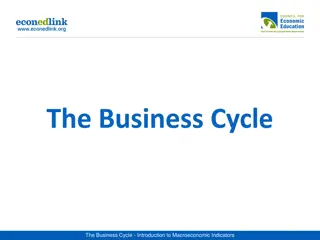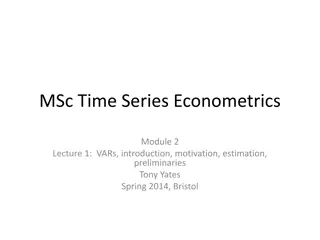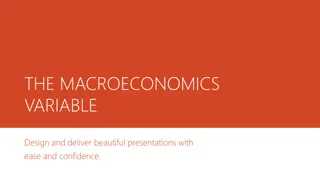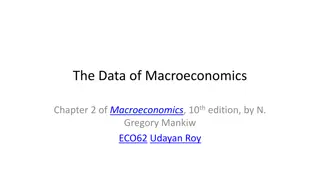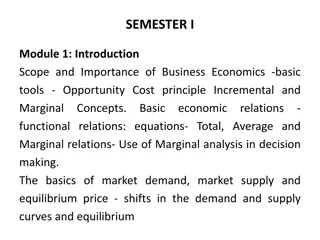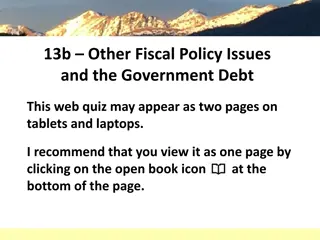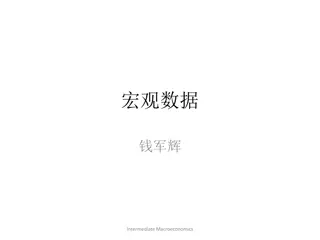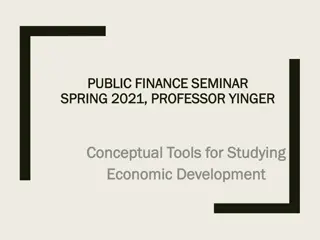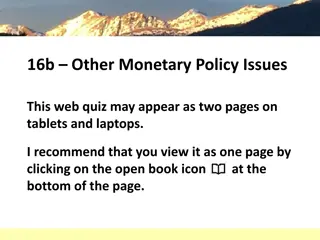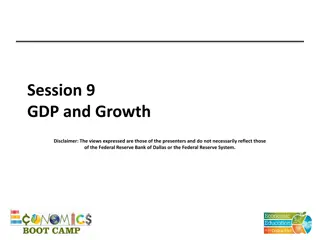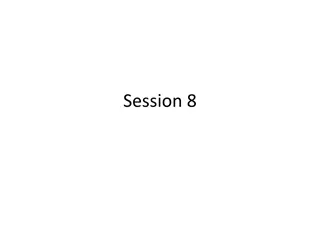Understanding the Scope of Managerial Economics
Managerial economics plays a crucial role in decision-making processes within businesses, focusing on optimizing limited resources for profit maximization. It encompasses both microeconomics and macroeconomics, utilizing economic theories to analyze the business environment. Key aspects such as dema
2 views • 6 slides
MacroLab Lite for Introductory Macroeconomics
MacroLab Lite is a simplified macroeconomic modeling tool designed to introduce students to system dynamics. Developed by Professor David Wheat, this tool focuses on basic equations and key structural elements of supply and demand sides. It emphasizes simplicity while covering important economic fac
2 views • 14 slides
Understanding Consumption, Saving, and Investment in Economics
Consumption in macroeconomics refers to total spending on consumer goods and services, while saving is the act of abstaining from consumption. Investment involves creating capital goods and acquiring financial assets. Engle's Law states that the proportion spent on necessities decreases with income.
0 views • 13 slides
Understanding FRED: An Introduction to Economic Data Tools
Explore the versatile features of FRED, a leading economic data aggregator platform. Learn how to use FRED for charting, data analysis, and more with this comprehensive tutorial by Mike Aguilar. Dive into advanced charting tools, data transformation techniques, and practical use cases in macroeconom
3 views • 29 slides
Understanding Fiscal Policy Options in Economics
Explore the evolution of economic theories including classical economics, demand-side economics, and supply-side economics. Learn about the impact of key figures like John Maynard Keynes and Milton Friedman on fiscal policy decisions and the U.S. economy. Delve into the strategies employed during th
0 views • 18 slides
Determinants of Total Production in Macroeconomics
An economy's total production of goods and services (GDP) is influenced by the quantity of inputs, known as the Factors of Production, and the ability to transform inputs into output through the production function. The key factors of production are capital and labor, and the production function det
0 views • 37 slides
Understanding Economics: Foundations and Concepts
Explore the core principles of economics, including scarcity, incentives, trade-offs, opportunity costs, and marginal thinking. Discover how these concepts shape individual decisions, market dynamics, and overall economic behavior. Learn about microeconomics and macroeconomics, and how they provide
0 views • 26 slides
Understanding International Macroeconomics: Trade Balance and Capital Flows
This unit delves into the basics of international macroeconomics, focusing on the trade balance, capital flows, and exchange rates. Explore concepts like exports, imports, net exports, and factors influencing a country's trade position through interactive learning and real-world examples.
1 views • 17 slides
Understanding Aggregate Demand in Macroeconomics
Economic well-being in the aggregate economy is determined by Real GDP, influenced by current levels of Aggregate Demand (AD) and Aggregate Supply (AS). Aggregate Demand slopes downward due to various effects like Wealth Effect and Interest Rate Effect. It is crucial in determining total spending in
4 views • 13 slides
Exploring Economics: Why Study, Skills Acquired, and Module Overview
Dive into the world of economics to understand why studying it is important and what skills you can develop. Explore modules covering microeconomics, macroeconomics, quantitative methods, international economics, and more, preparing you for a career in economic analysis and decision-making within th
0 views • 4 slides
Understanding Keynesian Consumption and Savings Functions in Macroeconomics
Keynesian consumption function details the relationship between total consumption and gross national income. It emphasizes the stability of aggregate consumption and the marginal propensity to consume. Similarly, Keynesian savings function illustrates the link between savings and national income, hi
0 views • 6 slides
Origin of Hedge Funds and MMT's Economic Principles
Hedge funds began with relative value sovereign bond trades, while Modern Monetary Theory (MMT) emphasizes government as the supplier of jobs for full employment. MMT challenges traditional economic norms, advocating for deficit spending and disregarding the need for balancing budgets. It integrates
0 views • 22 slides
Critique of Keynesian Economic Theory
Keynesian economic theory, though groundbreaking, faces several limitations. These include contradictions between equilibrium and unemployment, neglect of long-term analysis, assumptions of perfect competition and a closed economy, lack of generality, and a static rather than dynamic focus. Critics
0 views • 9 slides
Understanding Inflation: Types, Causes, Effects, and Control Measures in Macroeconomics
Inflation, the increase in the general price level over time, is explored in-depth covering different types like demand-pull and cost-push, their causes, effects on production, wealth distribution, employment, government investment, and purchasing power, along with measures to control inflation incl
0 views • 8 slides
Understanding Fiscal Policy to Combat Recessions
Explore the role of fiscal policy in fighting recessions through stimulating aggregate demand, using government spending and tax cuts. Learn about the Keynesian multiplier effect, MPC, and different policy responses to economic fluctuations. Discover how government interventions can help stabilize t
0 views • 47 slides
Contrasting Austrian Economics vs. Keynesian Macroeconomics
Austrian Economics emphasizes human action, voluntary saving, and analyzing the entire economic order, while Keynesian Macroeconomics views the economy as inherently unstable and focuses on factors like spending, investment, and interest rates to manage recession risks. The modern macroeconomics app
0 views • 15 slides
Understanding Keynesian Economics: Effective Demand and Aggregate Supply
Keynesian economics emphasizes the importance of effective demand in determining income, output, and employment levels. Effective demand, as outlined by Keynes, is the equilibrium level of demand that is met by aggregate supply to maintain stable employment and output levels. It is influenced by fac
0 views • 37 slides
Understanding Keynesian Consumption and Savings Functions in Macroeconomics
Keynesian Consumption Function relates total consumption to national income, with stable characteristics like MPC and APC. Savings Function shows the relationship between savings and income, highlighting the Marginal Propensity to Save and Average Propensity to Save. Both functions are essential con
0 views • 6 slides
Using Excel Simulator in Teaching Macroeconomics: A Modern Approach
Explore the benefits of incorporating a macroeconomics simulator in teaching, focusing on addressing challenges in understanding model dynamics and how different models relate to each other. The simulator helps students grasp complex concepts such as shocks, policy responses, and real-world applicat
0 views • 23 slides
Exploring Ideal Money and Keynesianism in Economic Policies
Exploring the concept of "ideal money" in contrast to Keynesian influences on central banks and treasuries. The discussion touches upon the stability of currency values, Nixon's declaration of being Keynesian, and how Keynesianism is approached as a political movement seeking wealth redistribution f
0 views • 22 slides
Understanding Demand in Macroeconomics: Key Concepts and Laws
Exploring the fundamental concepts of demand in AP Macroeconomics, including quantity demanded, demand schedules, the law of demand, and key terms. Practice questions help reinforce learning by testing knowledge on factors affecting demand for various goods. Through visual aids and explanations, rea
0 views • 17 slides
Understanding Endogenous Inflation Expectations in Macroeconomic Models
The paper discusses how inflation expectations were well anchored in the 2000s compared to the 1970s, exploring the factors that influenced this phenomenon. It introduces a model that includes endogenous inflation expectations and highlights the feedback, decreasing gain, and regime-switching featur
0 views • 18 slides
Understanding the IS-LM Model for Macroeconomic Analysis
The IS-LM model, discussed in Chapter 12 of Macroeconomics, helps analyze how an economy responds to policy changes and shocks in the short run. By understanding the IS and LM curves and their intersection, we can evaluate short-run macroeconomic outcomes for real interest rates (r) and real output
0 views • 103 slides
Understanding the IS-LM Model in Macroeconomics
This content delves into the IS-LM theory of static short-run macroeconomics, focusing on the goods market in the short run. It discusses the difference between real and nominal variables, recaps long-run macroeconomics, and explores the Keynesian Cross theory to understand short-run equilibrium. Ex
0 views • 74 slides
Comparison of Teaching Approaches in Tertiary Education: A Multiple Methods Investigation
Ms. Rhonda D. Dookwah presents a Ph.D. thesis defense on comparing two teaching approaches in Trinidad and Tobago's tertiary education system. The study explores the effectiveness of Teacher-Centered Instruction (TCI) and Problem-Based Learning (PBL) through quantitative data analysis in subjects li
0 views • 87 slides
Mid-Year Sector Review: Healthcare Insights
This mid-year sector review delves into the healthcare industry, highlighting key aspects such as companies catering to health needs, market segments, sector outlook, recent headlines, macroeconomics, and key drivers like governmental regulation, R&D, and the economy. The analysis covers a range of
0 views • 32 slides
Marx Versus Keynes: A Critical Examination of Economic Theories
Michael Roberts critiques Marx's Capital as scientifically erroneous and irrelevant to the modern world, contrasting it with Keynesian economics which questions the applicability of communist doctrine in contemporary society. The debate revolves around value theory, production, economic crises, and
0 views • 41 slides
Understanding the Business Cycle in Macroeconomics
The business cycle refers to the fluctuations in an economy, with phases like peak, expansionary, trough, and contractionary. During expansionary phases, output increases, unemployment decreases, and inflation may rise. Conversely, contractionary phases see output decline, unemployment rise, and red
0 views • 6 slides
Introduction to Vector Autoregressions in Econometrics
Explore the world of Vector Autoregressions (VARs) in econometrics with Tony Yates. This lecture provides an overview of VARs, including motivation, estimation techniques, and key concepts such as identification and factors models. Learn about the applications of VARs in macroeconomics and the resou
3 views • 54 slides
Understanding Macroeconomics: Key Concepts and Components
Dive into the world of macroeconomics with a focus on Gross Domestic Product (GDP), value added, circular flow of income, and expenditure components. Learn about the relationship between expenditure and income, the calculation of value added, and the distinction between final goods and intermediate
0 views • 22 slides
Understanding Gross Domestic Product (GDP) in Macroeconomics
This chapter delves into the significance of Gross Domestic Product (GDP) as a measure of economic activity, explaining its components, measurement, and connection to national income. It covers the concepts of GDP, final vs. intermediate goods, expenditure components, and consumption within the cont
0 views • 75 slides
Understanding Business Economics Fundamentals
Business economics delves into the efficient allocation of scarce resources within a business context, focusing on principles such as opportunity cost, marginal analysis, market demand and supply, and strategic decision-making. It encompasses microeconomics and macroeconomics, studying both individu
0 views • 37 slides
Macroeconomic Policy for Development and Decent Work in South Africa
This research agenda delves into the core conclusions, policy context, and objectives of macroeconomic policy for facilitating development and decent work in South Africa. Key points include the need for structural transformation, challenges in job creation, and the link between macroeconomics, empl
0 views • 44 slides
Understanding Fiscal Policy Issues and the Government Debt
Explore the causes of the Great Depression, differing views on fiscal policy, impacts of budget deficits on trade deficits, and key issues related to government debt. Learn about public debt concerns, effects of Social Security and Medicare programs, and debates on balanced budget amendments. Delve
0 views • 53 slides
Understanding China's Economic Growth Through Macroeconomics Analysis
Explore the intricate details of China's GDP evolution, real GDP growth, and the concepts of intermediate macroeconomics. Dive into the circular flow, GDP imputation, deflators, and more as you analyze China's economic performance from 1953 to 2022. Uncover the interplay between nominal and real GDP
0 views • 58 slides
Understanding Economic Development: Tools and Models for Analysis
Exploring conceptual tools for studying economic development, this seminar delves into key macroeconomic models such as Keynesian, export-base, and input-output models. The simplicity and implications of a Keynesian model, including the role of savings, consumption, investments, and trade, are discu
0 views • 42 slides
Understanding Microeconomics and Macroeconomics in Economics
Microeconomics focuses on individual economic actors like households and firms, while Macroeconomics studies the economy as a whole, addressing questions related to income, prices, production, and government interventions. The relationship between Micro and Macro is highlighted, emphasizing the impo
0 views • 37 slides
Understanding Monetary Policy: Mainstream vs. Monetarist Perspectives
Learn about the strengths and shortcomings of monetary policy, compare mainstream (Keynesian) and monetarist (Classical) views on macroeconomic instability, discuss self-correction in the economy, and explore the debate between rules and discretion in conducting stabilization policy. Key terms inclu
0 views • 52 slides
Key Concepts in Macroeconomics: Understanding GDP and Economic Growth
This content covers essential topics in macroeconomics such as Gross Domestic Product (GDP), economic growth, key economic measurements, and factors affecting growth like productivity, technology, and trade. It explains the significance of macroeconomics in analyzing the big picture of the economy,
0 views • 43 slides
Understanding Microeconomics and Macroeconomics in Economics
Explore the two subfields of economics - Microeconomics, focusing on individual decisions and market interactions, and Macroeconomics, examining the economy as a whole. Discover the key questions answered by Macroeconomics, the relationship between Micro and Macro, and the importance of economic gro
0 views • 37 slides

